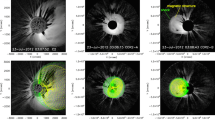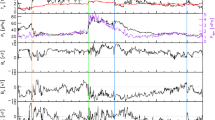Abstract
The Bastille Day (14 July) 2000 CME is a fast, halo coronal mass ejection event headed earthward. The ejection reached Earth on 15 July 2000 and produced a very significant magnetic storm and widespread aurora. At 1 AU the Wind spacecraft recorded a strong forward shock with a speed jump from ∼ 600 to over 1000 km s−1. About 6 months later, this CME-driven shock arrived at Voyager 2 (∼ 63 AU) on 12 January 2001 with a speed jump of ∼ 60 km s−1. This provides a good opportunity to study the shock propagation in the outer heliosphere. In this study, we employ a 2.5-D MHD numerical model, which takes the interaction of solar wind protons and interstellar neutrals into account, to investigate the shock propagation in detail and compare the model predictions with the Voyager 2 observations. The Bastille Day CME shock undergoes a dramatic change in character from the inner to outer heliosphere. Its strength and propagation speed decay significantly with distance. The model results at the location of Voyager 2 are in good agreement with in-situ observations.
Similar content being viewed by others
References
Axford, W. I.: 1972, NASA Spec. Publ. 308, 609.
Burlaga, L. F. et al.: 1986, J. Geophys. Res. 91, 13331.
Burlaga, L. F. et al.: 1994, J. Geophys. Res. 99, 21511.
Burlaga, L. F. et al.: 2001, Solar Phys., this issue.
Collela, R. and Woodward, P. R.: 1984, J. Comput. Phys. 54, 174.
Dai, W. and Woodward, P. R.: 1995, J. Comput. Phys. 121, 51.
Gloeckler, G. et al.: 1993, Science 261, 70.
Gloeckler, G. et al.: 1994, J. Geophys. Res. 99, 16637.
Holzer, T. E.: 1972, J. Geophys. Res. 77, 5407.
Hundhausen, A. J.: 1985, AGU Monograph 34, 37.
Lallement, R., Bertaux, J. L., Chassefiene, E., and Sandal, B. R.: 1990, in S. Grzedzielski and D. E. Page (eds.), Physics of the Outer Heliosphere, Pergamon, Tarrytown, N.Y., p. 73.
McComas, D. J., Gosling, J. T., and Skoug, R. M.: 2000, Geophys. Res. Lett. 27, 2437.
Mobius, E., Hoverstadt, D., Klecker, B., Gloeckler, G., and Ipavich, F. M.: 1985, Nature 318, 426.
Rice, W. K. M. and Zank, G. P.: 1999, J. Geophys. Res. 104, 12563.
Richardson, J. D., Paularena, K. I., Lazarus, A. J., and Belcher, J. W.: 1995, Geophys. Res. Lett. 22, 1469.
Vasyliunas, V. M. and Siscoe, G. L.: 1976, J. Geophys. Res. 81, 1247.
Wang, C. and Belcher, J. W.: 1999, J. Geophys. Res. 104, 549.
Wang, C., Richardson, J. D., and Gosling, J. T.: 2000a, Geophys. Res. Lett. 27, 2429.
Wang, C., Richardson, J. D., and Gosling, J. T.: 2000b, J. Geophys. Res. 105, 2337.
Wang, C., Richardson, J. D., and Paularena, K. I.: 2001, J. Geophys. Res. in press.
Whang, Y. C.: 1991, Space Sci. Rev. 57, 339.
Whang, Y. C., Lu, J. Y., and Burlaga, L. F.: 1999, J. Geophys. Res. 104, 19787.
Zank, G. P. and Pauls, H. L.: 1997, J. Geophys. Res. 102, 7037.
Author information
Authors and Affiliations
Electronic supplementary material
Rights and permissions
About this article
Cite this article
Wang, C., Richardson, J.D. & Burlaga, L. Propagation of the Bastille Day 2000 CME Shock in the Outer Heliosphere. Sol Phys 204, 413–423 (2001). https://doi.org/10.1023/A:1014293527951
Issue Date:
DOI: https://doi.org/10.1023/A:1014293527951




